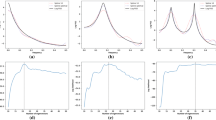Abstract
A generalized, multivariate version of the Posterior Singular Spectrum Analysis (PSSA) method is described for the identification of credible features in multivariate time series. We combine Bayesian posterior modeling with multivariate SSA (MSSA) and infer the MSSA signal components with a credibility analysis of the posterior sample. The performance of multivariate PSSA (MPSSA) is compared to the single-variate PSSA with an artificial example and the potential of MPSSA is demonstrated with real data using NAO and SOI climate index series.









Similar content being viewed by others
References
Allen M, Robertson A (1996) Distinguishing modulated oscillations from coloured noise in multivariate datasets. Clim Dyn 12:775–784
Allen M, Smith L (1996) Monte Carlo SSA: detecting irregular oscillations in the presence of colored noise. J Clim 9(12):3373–3401
Broomhead DS, King G (1986a) Extracting qualitative dynamics from experimental data. Physica D 20:217–236
Broomhead DS, King G (1986b) On the qualitative analysis of experimental dynamical systems. In: Sarkar S (ed) Nonlinear phenomena and chaos. Adam Hilger, Bristol, Boston, pp 113–144
Erästö P, Holmström L (2005) Bayesian multiscale smoothing for making inferences about features in scatter plots. J Comput Graph Stat 14(3):569–589
Erästö P, Holmström L (2007) Bayesian analysis of features in a scatter plot with dependent observations and errors in predictors. J Stat Comput Simul 77(5):421–431
Feliks Y, Groth A, Robertson A, Ghil M (2013) Oscillatory climate modes in the Indian monsoon, North Atlantic, and Tropical Pacific. J Clim 26(23):9528–9544
Godtliebsen F, Marron JS, Chaudhuri P (2004) Statistical significance of features in digital images. Image Vis Comput 22(13):1094–1104
Golyandina N (2010) On the choice of parameters in singular spectrum analysis and related subspace-based methods. Stat Interface 3:259–279
Golyandina N, Stepanov D (2005) SSA-based approaches to analysis and forecast of multidimensional time series. In: Proceedings of the 5th St. Petersburg workshop on simulation, St. Petersburg, Russia, pp 293–298
Golyandina N, Usevich K (2010) 2D-extension of singular spectrum analysis: algorithm and elements of theory. In: Olshevsky V, Tyrtyshnikov E (eds) Matrix methods: theory, algorithms and applications. World Scientific, Singapore, pp 449–473
Golyandina N, Zhigljavsky A (2013) Singular spectrum analysis for time series, SpringerBriefs in statistics. Springer, Heidelberg
Golyandina N, Nekrutkin V, Zhigljavsky A (2001) Analysis of time series structure, SSA and related techniques. Monographs on statistics and applied probability. Chapman & Hall/CRC, Boca Raton
Golyandina N, Korobeynikov A, Shlemov A, Usevich K (2015) Multivariate and 2D extension of singular spectrum analysis with the Rssa package. J Stat Softw 67(2):1–78
Hassani H, Xu Z, Zhigljavsky A (2011) Singular spectrum analysis based on perturbation theory. Nonlinear Anal Real World Appl 12(5):2752–2766
Holmström L, Pasanen L (2012) Baysian scale space analysis of differences in images. Technometrics 54(1):16–29
Holmström L, Launonen I (2013) Posterior singular spectrum analysis. Stat Anal Data Min 6(5):387–402
Jones PD, Jonsson T, Wheeler D (1997) Extension to the North Atlantic Oscillation using early instrumental pressure observations from Gibraltar and South-West Iceland. Int J Climatol 17:1433–1450
Korobeynikov A (2010) Computation- and space-efficient implementation of SSA. Stat Interface 3(3):357–368
Ojala AEK, Launonen I, Holmström L, Tiljander M (2015) Effects of solar forcing and North Atlantic oscillation on the climate of continental Scandinavia during the Holocene. Quatern Sci Rev 112:153–171. doi:10.1016/j.quascirev.2015.01.021
Pasanen L, Launonen I, Holmström L (2013) A scale space multiresolution method for extraction of time series features. Stat 2(1):273–291
Shlemov A, Golyandina N (2014) Shaped extensions of singular spectrum analysis. In: 21st International symposium on mathematical theory of networks and systems, Groningen, The Netherlands, pp 1813–1820
Author information
Authors and Affiliations
Corresponding author
Additional information
Ilkka Launonen: Research supported by Academy of Finland Project No. 250862 and a grant from the Alfred Kordelin Foundation.
Lasse Holmström: Research supported by Academy of Finland Project No. 250862.
Rights and permissions
About this article
Cite this article
Launonen, I., Holmström, L. Multivariate posterior singular spectrum analysis. Stat Methods Appl 26, 361–382 (2017). https://doi.org/10.1007/s10260-016-0372-9
Accepted:
Published:
Issue Date:
DOI: https://doi.org/10.1007/s10260-016-0372-9




